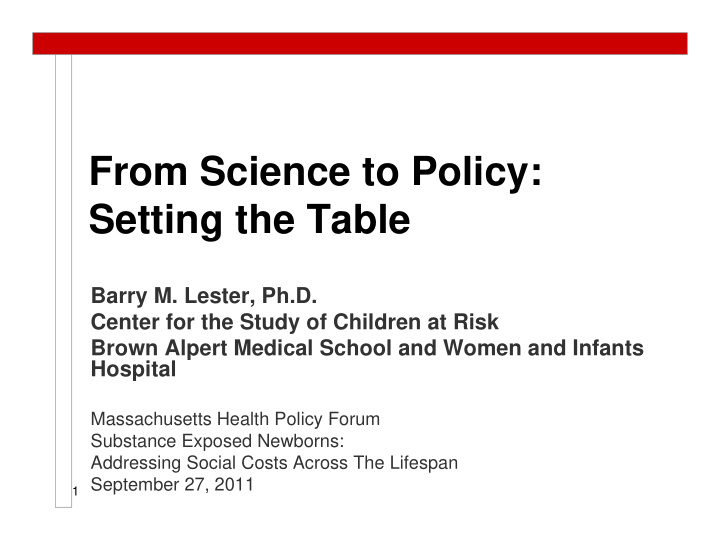



From Science to Policy: Setting the Table Barry M. Lester, Ph.D. Center for the Study of Children at Risk Brown Alpert Medical School and Women and Infants Hospital Massachusetts Health Policy Forum Substance Exposed Newborns: Addressing Social Costs Across The Lifespan September 27, 2011 1
Children at Risk Children in the U.S. are facing a “perfect storm” Problems for children are increasing at the same time that resources for helping children are diminishing
History and Headlines In the U. S. in the 1980s, early reports on prenatal cocaine effects created a public frenzy about “unfit to parent” women and their damaged “crack babies."
History and Headlines Based on insufficient and inaccurate information, society over-reacted. Women were prosecuted, children were removed from their birth mothers, families were split up.
History and Headlines By the mid 1990s, the number of children in foster care reached an all-time high of over 500,000. Many of these children suffered emotional problems from multiple foster care placements.
Substance Use During Pregnancy and Child Outcome GENETIC AND PRENATAL ENVIRONMENT PRENATAL POSTNATAL TERATOGENIC CAREGIVING ENVIRONMENT IMMEDIATE LATENT SPECIFIC GENERAL COA RISK TRANSIENT LONG LASTING PROTECTIVE BRAIN AND BEHAVIORAL DEVELOPMENT
Summary of Prenatal Substance Use Effects Prenatal exposure effects are similar for most substances at typical levels of use It is virtually impossible to compare the effects of one substance with another Most effects are small to moderate and may not show up until childhood Most effects can be treated Prenatal exposure effects can be magnified by environmental adversity Prenatal exposure effects need to be interpreted in the context of the caregiving environment
Disconnect Between Science and Policy Houston, we’ve got at Problem
Policy Responses 2 parallel policy responses towards drug use by women Punitive Treatment
Problems with Punitive Policies Fear of being reported drives women away from health care system (e.g. prenatal care) Denies the opportunity to parent for those who can/want to parent Overburdens foster care system Child’s ability to form attachments is jeopardized by multiple foster placements
Treatment Drug use by pregnant women viewed as a mental health (medical) issue Harm reduction Focus on: reproductive health care ° substance abuse and mental health treatment ° relationship with child °
Addiction Can Be Treated Partial Recovery of Brain Dopamine Transporters in Methamphetamine Abuser After Protracted Abstinence 3 0 ml/gm Normal Control METH Abuser METH Abuser (1 month detox) (24 months detox) (Volkow, ND et al., Journal of Neuroscience 21, 9414-9418, 2001)
( Lester and Twomey, Women’s Health 2008)
Model Programs Individualized Family centered Comprehensive Interdisciplinary staff Nonjudgmental, nonpunitive, nurturing, culturally appropriate Parenting programs Mental health co-morbidities and women’s issues Child care Transportation (Lester, Andreozzi & Appiah, Harm Reduction J ., 2004)
Vulnerable Infants Program of Rhode Island (VIP-RI) Reduced length of stay in hospital beyond medical necessity Reduced number of infants placed in foster care at hospital discharge Family Treatment Drug Court: ° 84% of infants in permanent placement by 12 months ° 78% of these with biological parents or relatives (Twomey et al Child Welfare , 2010)
What Have We Learned? Our understanding of addiction has changed We know more about addiction as a disease – a medical condition that can be treated Addiction is a complex disease with multiple mental health co-morbidities Women who use drugs also tend to be depressed and anxious and may have even more severe mental health problems. The bad news: Addiction is complex The good news: Addiction is treatable Affected infants can be identified and treated
While there are drug users who are inadequate mothers, there are also drug users who are competent mothers who, with treatment, can care for their children. Families can be preserved. Failure to take advantage of what we have learned is not only a missed opportunity but a giant step backward.
Recommend
More recommend